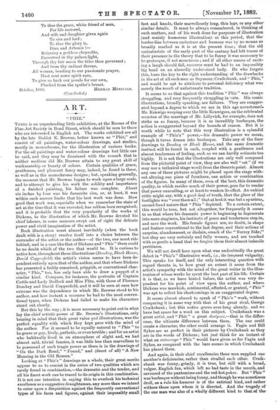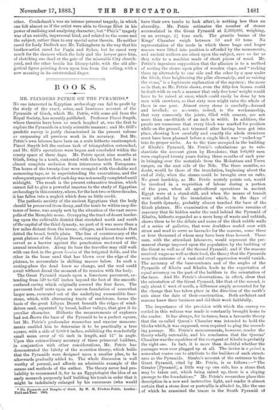ART.
" PHIZ."
THERE is an unpretending little exhibition, at the Rooms of the Fine-Art Society in Bond Street, which should be seen by those who are interested in English art. The works exhibited are all by the late Hablot K. Browne, better known as "Phiz," and consist of oil paintings, water-colour drawings, and studies, mostly in monochrome, for the illustration of various books. For the oil paintings and water-colour drawings but little can be said, and they may be dismissed with the remark that in neither medium did Mr. Browne attain to any great skill of workmanship or beauty of colour. Certain qualities of grace, gentleness, and pleasant fancy may, indeed, be found in these, as well as in the monochrome designs ; but, speaking generally, the moment that Mr. Browne began to work upon a large scale, and to attempt to give his work the solidity and importance of a finished painting, his failure was complete. About six inches by four was his favourite size, or, at least, it was within such narrow limits that his best work was done. How good that work was, especially when we remember the state of art at the time that it was executed, has seldom been recognised; and it is probable that the very popularity of the works of Dickens, to the illustration of which Mr. Browne devoted his chief labours, in some measure swept out of sight the delicate power and vivid imagination of the artist.
Book illustration must almost inevitably (when the book dealt with is a story) resolve itself into a choice between the surrender of the artist or the author—of the two, one must ride behind; and in a case like that of Dickens and "Phiz" there could be no doubt which of the two that would be. It is curious to notice how, throughout these illustrations (Donibey,Bleak House, David Copperfield) the artist's vision seems to have been de- pendent entirely upon that of the author, and that where Dickens has presented a feebly conceived, priggish, or conventional char- acter, " Phiz," too, has ouly been able to draw a puppet of a similar kind. Compare, for instance, the portraits of Captain Cuttle and Lady Dedlock and Miss Flite, with those of Florence Dombey and David Copperfield, and it will be seen at once how extreme was the dependence in which Mr. Browne stood to his author, and how instant a recourse he had to the most conven- tional types, when Dickens had failed to make his characters stand out clearly.
But this by the way ; it is more necessary to point out in what lay the chief artistic power of Mr. Browne's illustrations, only bearing in mind that their great value qud illustrations, was the perfect equality with which they kept pace with the mind of the author. For it seemed to be equally natural to "Phiz " to be grave or gay, lively, pathetic, or even terrible ; and for an artist who habitually lived in an atmosphere of slight and, we had almost said, trivial fancies, it was little less than marvellous to be possessed of such tragic power as there is in the drawings of " On the Dark Road," " Found," and (finest of all) " A New Meaning in the Old Roman."
Looking at " Phiz's " drawings as a whole, their great merits appear to us to consist in the union of two qualities which are rarely found in combination,—the dramatic and the tender, and all his finest work can be traced to its origin in this combination. It is not our intention in saying this to overlook his technical excellence as a suggestive draughtsman, any more than we intend to enter upon a disquisition against the frequently conventional types of his faces and figures, against their impossibly small
feet and hands, their marvellously long, thin legs, or any other• similar details. It must be always remembered, in thinking of such matters, and of his work done for purposes of illustration- (and mainly humorous illustration) at this period, that the• border-line between caricature and humour was by no means an broadly marked as it is at the present time ; that the old caricaturists of the early part of the century had left traces of their presence in the theory that to be funny it was necessary to- be grotesque, if not monstrous ; and if all other means of excit- ing a laugh should fail, recourse must be had to an impossibly big head on an absurdly under-sized body. He who forgets. this, loses the key to the right understanding of the drawbacks in the art of all such men as Seymour, Cruikshank, and "Phiz," and would be apt to attribute to personal deficiency what was merely the result of unfortunate tradition.
It seems to us that against this tradition " Pliiz " was always. struggling, and very frequently struggling in vain. His comic.
illustrations, broadly speaking, are failures. They are exagger- ated beyond a degree to which we are in this age accustomed. Mr. Kenwigs weeping over the little Kenwigses, on the celebrated occasion of the marriage of Mr. Lillyvick, for example, does not strike us as funny, because it is so incredibly burlesque, the action is exaggerated beyond the bounds of reason. But it is.
worth while to note that this very illustration is a splendid example of " Phiz's " power,—his dramatic power we mean, though it turns drama into burlesque. Take any of the finer drawings to Dombey or Bleak House, and the same dramatic instinct will be found in each, coupled with a gentleness and almost tenderness of feeling, stitch as we can hardly estimate too highly. It is not that the illustrations are only well composed from the pictorial point of view, they are also well " set " (if we may use a technical stage word) from the theatric point. Almost any one of these pictures might be placed upon the stage with- out altering one piece of furniture, one action or combination of the figures. In many of them, even of the best, this dramatic.
quality, in which resides much of their power, goes far to render that power unavailing, or at least to weaken its effect. An unkind. critic might say, with a good deal of truth, that the glare of the
footlights was " over them all ;" that at best it was but a spurious, second-hand nature that "Phiz " depicted. To a certain extent, this would be true, but not altogether,-for frequently it seems to us that where his dramatic power is beginning to degenerate into mere staginess, his instincts of grace and tenderness step in, and save the work. His female figures are, no doubt, in shape and feature conventional to the last degree, and their actions of surprise, abandonment, or disdain, smack of the " Surrey Side;" but they are very certainly and fully women, and are touched with so gentle a hand that we forgive them their almost imbecile prettiness.
We will not dwell here upon what was undoubtedly the great defect in " Phiz's " illustrative work, i.e., its frequent vulgarity.. This speaks for itself, and the only interesting question with regard thereto is, to how great an extent it arose from the artist's sympathy with the mind of the great writer in the illus-
tration of whose works he spent the best part of his life. Certain' it is that, as we have hinted before, the artist was very de- pendent for his point of view upon the author, and where. Dickens was mawkish, sentimental, affected, or genteel, " Phiz was apt to reflect his shortcomings in an exaggerated degree.
It seems almost absurd to speak of " Phiz's " work, without comparing it in some way with that of his great rival, George Cruikshank ; but this notice grows over-long already, and we have but apace for a word on this subject. Cruikshank was a great artist, and " Phiz " a great designer,—that is the differ- ence, the ultimate difference between them. The one could_ create a character, the other could arrange it. Fagin and Bill Sykes are as perfect in their pictures by Cruikshank as they are in the words of Dickens ; but just think for an instant of what an entourage " Phiz" would have given us for Fagin and Sykes, as compared with the bare scenes in which Cruikshank has placed them.
And again, in their chief excellencies these men supplied one another's deficiencies, rather than rivalled each other. Cruik- shank was funny, grimly, it is true, but still with a broad,. vulgar, English fun, which left no bad taste in the mouth, and savoured of the pantomime and the red-hot poker. But " Phiz "- was burlesque without being funny, and though he was sometimes, droll, as a rule his humour is of the satirical kind, and rather withers those upon whom it is directed. And the tragedy of the one man was also of a wholly different kind to that of the,
other. Cruikshank's was an intense personal tragedy, in which one felt almost as if the artist were akin to George Eliot in his power of realising and analysing character; but "Phiz's" tragedy was of an outside, impersonal kind, and related to the scene and the subject, rather than to any special actor therein. He neither cared for Lady Dedlock nor Mr. Tulkinghorn in the way that his brother-artist cared for Fagiu and Sykes, but he cared very much for the chances which the lady and the lawyer gave him, of sketching one dead at the gate of the miserable City church- yard, and the other beside his library-table, with the old alle- gorical figure pointing down upon him from the ceiling, with a new meaning in its outstretched finger.



































 Previous page
Previous page